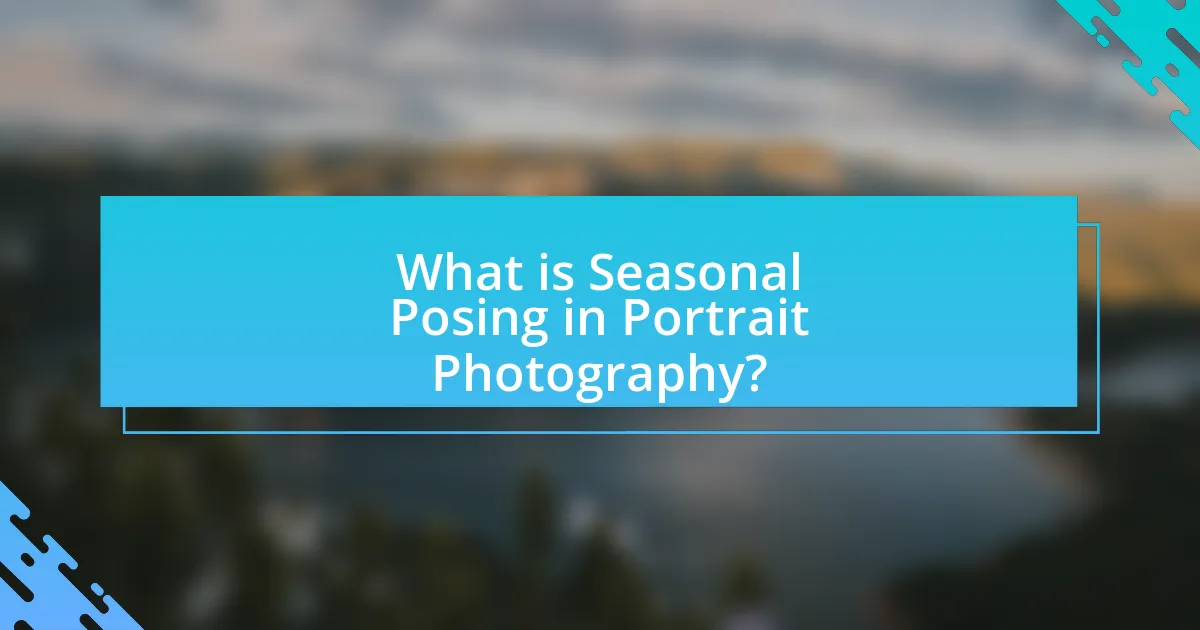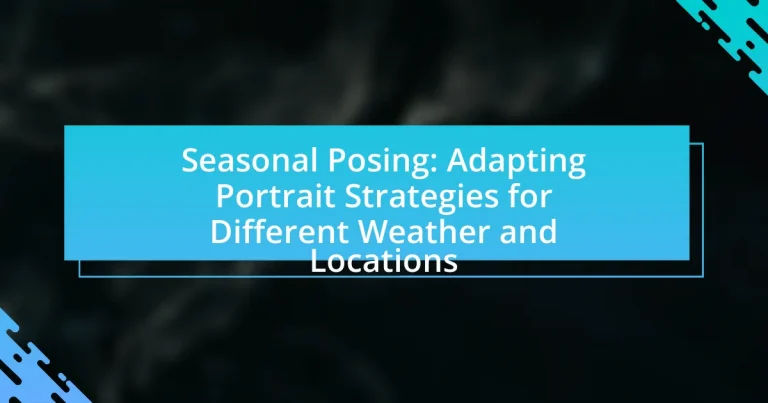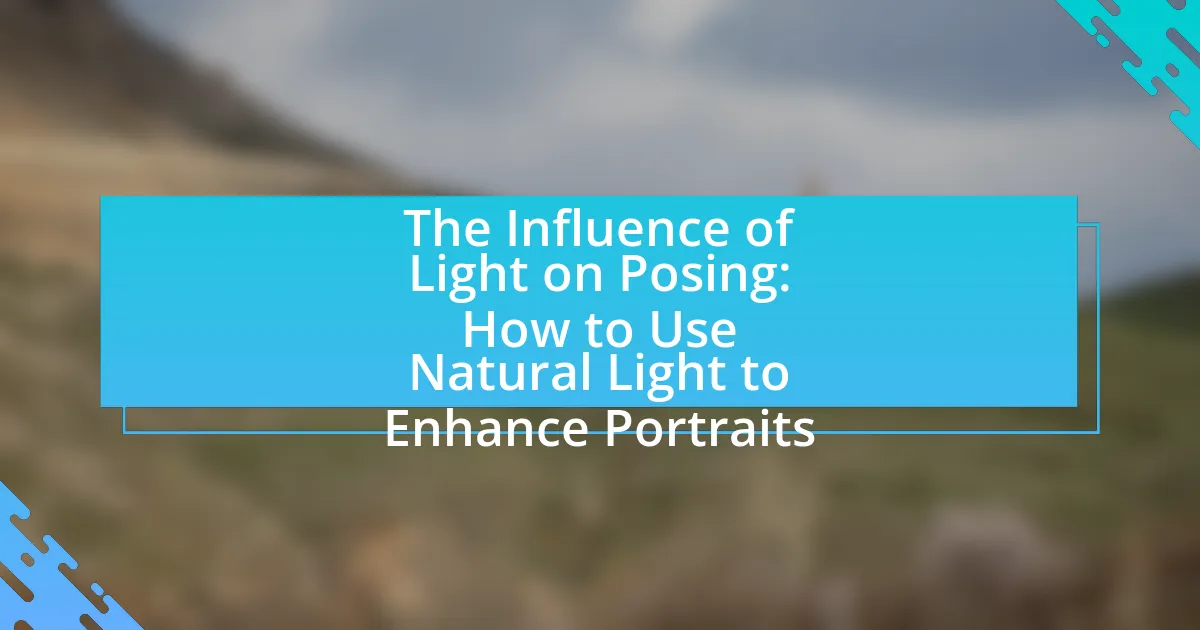Seasonal posing in portrait photography involves adjusting poses and compositions to reflect the unique characteristics of different seasons, enhancing the visual appeal of portraits through seasonal elements such as colors, lighting, and natural backdrops. This article explores how seasonal posing differs from traditional strategies, emphasizing adaptability to weather conditions and the emotional resonance of portraits. Key elements include the influence of seasons on pose selection, the importance of location, and techniques for managing lighting and clothing choices. Additionally, the article addresses common pitfalls photographers face and offers best practices for successful seasonal portrait sessions.

What is Seasonal Posing in Portrait Photography?
Seasonal posing in portrait photography refers to the practice of adjusting poses and compositions based on the characteristics of different seasons. This approach enhances the visual appeal of portraits by incorporating seasonal elements such as colors, lighting, and natural backdrops that are unique to each time of year. For instance, autumn may feature warm tones and falling leaves, while spring can highlight blooming flowers and vibrant greens. By aligning poses with these seasonal attributes, photographers can create more engaging and contextually relevant images that resonate with viewers.
How does Seasonal Posing differ from traditional portrait strategies?
Seasonal posing differs from traditional portrait strategies primarily in its adaptability to varying weather conditions and seasonal themes. While traditional portrait strategies often focus on static poses and controlled environments, seasonal posing incorporates dynamic elements such as natural light, seasonal colors, and outdoor settings that reflect the time of year. For instance, a summer portrait may utilize bright colors and outdoor backdrops, while a winter portrait might emphasize cozy attire and snowy landscapes. This approach enhances the emotional connection and relevance of the portrait to the viewer, making it more engaging and contextually appropriate.
What are the key elements of Seasonal Posing?
The key elements of Seasonal Posing include adapting poses to reflect the characteristics of each season, utilizing natural elements for context, and considering lighting variations. Seasonal poses should align with the mood and aesthetics of the season, such as vibrant colors in spring or warm tones in autumn. Incorporating elements like snow in winter or flowers in spring enhances the visual narrative. Additionally, understanding how different lighting conditions affect the subject’s appearance is crucial; for instance, softer light in fall can create a cozy atmosphere, while bright summer light may require adjustments to avoid harsh shadows. These elements collectively ensure that the poses resonate with the seasonal theme and enhance the overall portrait quality.
How does the season influence the choice of poses?
The season significantly influences the choice of poses by dictating the clothing, lighting, and overall mood of the portrait. For instance, in spring and summer, poses may emphasize outdoor settings, vibrant colors, and relaxed postures to reflect the warmth and liveliness of the season. Conversely, in autumn and winter, poses often incorporate layers, cozy settings, and more intimate compositions to convey the season’s cooler temperatures and introspective nature. This adaptability is essential for capturing the essence of each season, as evidenced by photographers who adjust their techniques based on seasonal characteristics, such as using softer lighting in winter to enhance warmth or vibrant backdrops in summer to create energy.
Why is it important to adapt portrait strategies for different weather conditions?
Adapting portrait strategies for different weather conditions is crucial because varying weather impacts lighting, mood, and the overall aesthetic of the portrait. For instance, overcast skies provide soft, diffused light that minimizes harsh shadows, ideal for flattering portraits, while bright sunlight can create stark contrasts and unflattering shadows. Additionally, weather influences the subject’s comfort and attire, which can affect their expression and pose. Research indicates that subjects are more relaxed and natural in comfortable environments, leading to better photographic outcomes. Therefore, adjusting strategies according to weather conditions enhances the quality and emotional resonance of portraits.
What challenges do photographers face in various weather conditions?
Photographers face several challenges in various weather conditions, including lighting issues, equipment protection, and subject comfort. For instance, harsh sunlight can create unflattering shadows and overexposed highlights, while low light during cloudy or rainy conditions can hinder image quality. Additionally, rain or snow poses risks to camera equipment, necessitating protective gear to prevent damage. Furthermore, extreme temperatures can affect both the photographer’s and the subject’s comfort, potentially impacting the quality of the shoot. These challenges require photographers to adapt their techniques and equipment to ensure successful outcomes in diverse weather scenarios.
How can weather enhance or detract from a portrait session?
Weather can significantly enhance or detract from a portrait session by influencing lighting, mood, and the overall aesthetic of the images. For instance, overcast conditions can provide soft, diffused lighting that reduces harsh shadows, creating a flattering effect on skin tones. Conversely, bright sunlight can lead to harsh shadows and squinting, which may detract from the subject’s expression and overall image quality. Additionally, seasonal elements like autumn foliage or spring blooms can add vibrant colors and context to portraits, enhancing their visual appeal. On the other hand, extreme weather conditions such as rain or snow can create challenges, potentially leading to discomfort for the subject and equipment issues, which may negatively impact the session.
What role do locations play in Seasonal Posing?
Locations play a crucial role in Seasonal Posing by influencing the aesthetic and thematic elements of portraits. Different locations provide unique backdrops that can enhance the mood and context of the photos, aligning with seasonal characteristics such as colors, lighting, and natural elements. For instance, a beach setting in summer offers vibrant colors and bright lighting, while a forest in autumn provides rich, warm tones and a sense of coziness. The choice of location can also dictate the type of poses and compositions that work best, as certain environments lend themselves to specific styles, such as candid shots in a lively park or formal portraits in an elegant urban setting. This adaptability to location is essential for capturing the essence of each season effectively.
How can different locations complement seasonal themes?
Different locations can complement seasonal themes by providing distinct backdrops that enhance the visual narrative of each season. For example, a beach setting during summer captures the essence of warmth and leisure, while a forest in autumn showcases vibrant foliage, creating a rich tapestry of colors. These contrasting environments not only reflect the characteristics of each season but also evoke specific emotions associated with them, such as joy in summer or nostalgia in fall. Research indicates that location choice significantly influences the mood and perception of photographs, as demonstrated in studies on environmental psychology, which show that natural settings can enhance feelings of well-being and connection to nature.
What are the best locations for seasonal portraits?
The best locations for seasonal portraits include parks, botanical gardens, beaches, and urban settings. Parks and botanical gardens offer vibrant foliage in spring and summer, while beaches provide stunning backdrops during sunset. Urban settings, with their unique architecture, can enhance portraits in any season. For example, Central Park in New York City is renowned for its picturesque landscapes year-round, making it a popular choice for seasonal photography.

How can photographers effectively adapt their techniques for different seasons?
Photographers can effectively adapt their techniques for different seasons by adjusting their lighting, composition, and subject interaction to suit the unique characteristics of each season. For instance, in spring, photographers can utilize the soft, diffused light and blooming flowers to create vibrant, colorful portraits, while in summer, they may need to manage harsh sunlight by using reflectors or diffusers to soften shadows. In autumn, the warm tones of falling leaves can enhance the mood of portraits, prompting photographers to focus on warm color palettes and natural backdrops. During winter, photographers should consider the challenges of low light and cold weather, often opting for indoor settings or utilizing artificial lighting to maintain clarity and warmth in their images. These adaptations are supported by the understanding that seasonal changes impact natural light quality, color temperature, and environmental elements, which are crucial for achieving desired photographic outcomes.
What specific techniques should be used for winter portraits?
For winter portraits, specific techniques include utilizing natural light, incorporating warm clothing, and using reflective surfaces. Natural light is crucial as it enhances skin tones and reduces harsh shadows; shooting during golden hour, shortly after sunrise or before sunset, provides soft, flattering light. Incorporating warm clothing not only adds visual interest but also keeps subjects comfortable, which is essential for capturing genuine expressions. Additionally, using reflective surfaces like snow can create beautiful highlights and enhance the overall composition. These techniques are effective in winter settings, as they address the unique challenges posed by cold weather and varying light conditions.
How can lighting be managed in winter conditions?
Lighting in winter conditions can be managed by utilizing natural light effectively and incorporating artificial light sources as needed. During winter, the sun is lower in the sky, which creates softer, diffused light; positioning subjects to take advantage of this natural light can enhance portrait quality. Additionally, using reflectors can help bounce light onto the subject, reducing shadows and improving overall illumination. When natural light is insufficient, employing portable LED lights or flash can provide necessary brightness and control over the lighting environment. These strategies ensure that portraits maintain clarity and vibrancy, even in challenging winter conditions.
What clothing choices enhance winter portrait sessions?
Layered clothing choices enhance winter portrait sessions by providing both warmth and visual interest. Wearing multiple layers allows for versatility in poses and can create depth in photographs. Fabrics such as wool, cashmere, and thermal materials are ideal as they retain heat while also offering texture. Additionally, incorporating accessories like scarves, hats, and gloves can add personality and color to the portraits. Bright colors or patterns can contrast beautifully against a snowy backdrop, making the subject stand out. Studies in fashion photography indicate that well-coordinated outfits can significantly improve the aesthetic appeal of portraits, particularly in winter settings where the environment can be stark.
What are the best practices for summer portrait sessions?
The best practices for summer portrait sessions include scheduling shoots during the golden hour, utilizing natural shade, and encouraging relaxed poses. Scheduling during the golden hour, which occurs shortly after sunrise or before sunset, provides soft, flattering light that enhances skin tones and reduces harsh shadows. Utilizing natural shade, such as trees or awnings, helps to avoid direct sunlight that can cause squinting and overexposure. Encouraging relaxed poses allows subjects to feel comfortable, resulting in more genuine expressions and a natural look. These practices are supported by photography guidelines that emphasize the importance of lighting and comfort in achieving high-quality portraits.
How can photographers utilize natural light during summer?
Photographers can utilize natural light during summer by taking advantage of the golden hour, which occurs shortly after sunrise and before sunset, providing soft, diffused lighting that enhances portraits. This time of day minimizes harsh shadows and creates a warm glow, ideal for capturing skin tones and textures. Additionally, photographers can use reflectors to bounce sunlight onto subjects, filling in shadows and adding dimension to the images. According to a study by the American Society of Photographers, utilizing natural light effectively can significantly improve the quality of outdoor portraits, making them more visually appealing.
What poses work best in hot weather?
In hot weather, poses that emphasize movement and openness work best. Poses such as standing with arms outstretched, walking, or playful interactions create a sense of airiness and help to convey a relaxed atmosphere. These poses allow for better airflow around the subject, reducing discomfort from heat. Additionally, incorporating natural elements like water or shade can enhance the visual appeal and provide relief from the sun. Research indicates that dynamic poses can evoke feelings of freedom and joy, which are particularly effective in warm environments.
How can fall and spring be leveraged for unique portrait opportunities?
Fall and spring can be leveraged for unique portrait opportunities by utilizing their distinct natural elements and lighting conditions. In fall, vibrant foliage provides a rich color palette, enhancing the visual appeal of portraits, while the softer, golden hour light creates flattering skin tones. Spring offers blooming flowers and lush greenery, which can serve as beautiful backdrops, along with longer daylight hours that allow for more flexible shooting times. These seasonal characteristics not only enhance the aesthetic quality of portraits but also evoke specific emotions and themes associated with each season, making the portraits more engaging and memorable.
What are the advantages of using fall foliage in portraits?
Using fall foliage in portraits enhances visual appeal through vibrant colors and rich textures. The warm hues of autumn leaves create a striking contrast against skin tones, making subjects stand out. Additionally, the natural setting provides a dynamic backdrop that adds depth and interest to the composition. Research indicates that seasonal elements, like fall foliage, can evoke emotions and nostalgia, enhancing the viewer’s connection to the image. This emotional resonance can lead to more impactful and memorable portraits.
How can spring blooms enhance portrait aesthetics?
Spring blooms enhance portrait aesthetics by providing vibrant colors and natural textures that create visually appealing backdrops. The presence of flowers like tulips and cherry blossoms introduces a lively atmosphere, which can evoke emotions and enhance the subject’s expression. Research indicates that colorful environments positively influence mood and perception, making portraits more engaging. For instance, a study published in the Journal of Environmental Psychology found that exposure to colorful natural settings can improve emotional well-being, thereby enhancing the overall impact of portrait photography.

What are the common pitfalls in Seasonal Posing and how can they be avoided?
Common pitfalls in seasonal posing include poor lighting choices, inappropriate clothing for the weather, and lack of preparation for environmental conditions. To avoid poor lighting, photographers should utilize natural light effectively, especially during golden hour, which enhances the subject’s appearance. In terms of clothing, selecting outfits that are suitable for the season not only ensures comfort but also complements the overall aesthetic; for instance, wearing layers in colder months can add depth to the images. Additionally, being prepared for environmental conditions, such as wind or rain, by having backup plans or equipment can prevent disruptions during the shoot. These strategies help create successful seasonal portraits that resonate with the intended atmosphere and setting.
What mistakes do photographers often make when adapting to seasonal changes?
Photographers often make the mistake of not adjusting their lighting techniques when adapting to seasonal changes. For instance, during winter, the lower sun angle can create harsh shadows, yet many photographers continue to use the same lighting setups as in summer, resulting in unflattering images. Additionally, they may overlook the impact of seasonal colors on their compositions; failing to incorporate autumn foliage or spring blooms can lead to less visually appealing portraits. Furthermore, photographers frequently neglect to adapt their wardrobe recommendations for clients based on seasonal weather, which can affect comfort and overall appearance in the final images. These mistakes can diminish the quality of the photographs and the overall client experience.
How can poor weather conditions be mitigated during a shoot?
To mitigate poor weather conditions during a shoot, photographers can utilize protective gear, plan for alternative locations, and adjust shooting schedules. Protective gear such as rain covers for cameras and waterproof clothing for subjects can prevent damage and discomfort. Planning for alternative indoor locations allows for continuity in shooting despite adverse weather. Adjusting shooting schedules to take advantage of breaks in weather or specific times of day with better conditions can enhance the quality of the shoot. These strategies are supported by industry practices that emphasize preparation and adaptability in varying weather scenarios.
What should photographers avoid when selecting locations?
Photographers should avoid locations that are overly crowded or noisy, as these factors can distract from the subject and hinder the overall quality of the portrait. Crowded areas can lead to interruptions during the shoot, making it difficult to capture the desired expressions and poses. Additionally, noise can interfere with communication between the photographer and the subject, complicating the posing process. Studies in environmental psychology indicate that serene and less populated settings contribute to better focus and emotional expression in photography, reinforcing the importance of selecting tranquil locations for effective portrait sessions.
What tips can help photographers succeed in Seasonal Posing?
Photographers can succeed in seasonal posing by adapting their techniques to the specific characteristics of each season. For instance, in spring, utilizing natural blooms can enhance the aesthetic, while in winter, incorporating warm clothing and cozy settings can create a comforting atmosphere. Additionally, understanding the lighting conditions unique to each season is crucial; for example, golden hour in summer provides soft, flattering light, whereas overcast days in fall can offer even illumination. Research indicates that seasonal themes resonate with clients, leading to increased engagement and satisfaction, as clients often seek to capture the essence of the season in their portraits.
How can preparation improve the outcome of seasonal portraits?
Preparation can significantly improve the outcome of seasonal portraits by ensuring optimal conditions for capturing images. By planning the shoot around the specific weather and lighting conditions typical for the season, photographers can enhance the visual appeal of the portraits. For instance, shooting during the golden hour, when natural light is soft and warm, can create a more flattering and aesthetically pleasing image. Additionally, selecting appropriate clothing and props that complement the season can add depth and context to the portraits, making them more engaging. Research indicates that well-prepared shoots yield higher satisfaction rates among clients, as they often result in more dynamic and visually compelling photographs.
What are the best practices for communicating with clients about seasonal themes?
The best practices for communicating with clients about seasonal themes include timely outreach, clear messaging, and personalized content. Timely outreach ensures that clients are informed well in advance of seasonal events, allowing them to plan accordingly. Clear messaging involves using straightforward language to convey the benefits of seasonal themes, such as how they enhance the relevance of portraits. Personalized content, tailored to individual client preferences and past interactions, fosters a stronger connection and increases engagement. Research indicates that personalized marketing can lead to a 20% increase in sales, highlighting the effectiveness of this approach in client communication.

















